Concentration Dependencies of Diffusion Permeability of Anion-Exchange Membranes in Sodium Hydrogen Carbonate, Monosodium Phosphate, and Potassium Hydrogen Tartrate Solutions
Abstract
1. Introduction
2. Materials and Methods
2.1. Membranes and Solutions
2.2. Experimental Methods
3. Results
3.1. Diffusion Permeability of Membranes in Solutions of Different Electrolytes
3.2. Phenomena Affecting Diffusion Permeability of Membranes in NaHCO3, NaH2PO4, KHT
3.2.1. Enrichment of the Membrane Internal Solution with Multiply Charged Anions
3.2.2. Increase in Membrane Pore Size
4. Conclusions
Supplementary Materials
Author Contributions
Funding
Acknowledgments
Conflicts of Interest
List of Abbreviations and Symbols
| Abbreviations | |
| AEM | anion-exchange membrane |
| CEM | cation-exchange membrane |
| KHT | potassium hydrogen tartrate |
| ED | electrodialysis |
| Subscript | |
| 1 | counterion |
| A | Co-ion |
| Symbols | |
| volumetric density of water, g cm–3 | |
| Gibbs hydration energy, J mol | |
| d | thickness of the membranes, μm |
| h | hydration number |
| Q | ion-exchange capacity of the membrane, mmol g–1 |
| partial molar volume of water, 18 cm3 mol–1 | |
| interfacial surface tension, 0.072 N m–1 | |
| θ | contact angle, degree |
| nw | number of water molecules per fixed group of AEM, molH2O mol–1 f.gr |
| V | integral volume of sorbed water per gram of dry membrane, cm3 g–1dry |
| Vt | total water content in the test sample, cm3 g–1dry |
| A | binding energy of water, J mol–1 |
| r | pore effective radius, nm |
| P | integral coefficient of diffusion permeability, cm2 s–1 |
| P* | differential coefficient of diffusion permeability, cm2 s–1 |
| diffusion permeability of the membrane gel phase, cm2 s–1 | |
| D | diffusion coefficient of the electrolyte, cm2 s–1 |
| α | structural parameter |
| transport numbers of ions i in the gel phase | |
| transport numbers of ions i in the electrolyte | |
| f1 | volume fraction of gel phase in the membrane |
| f2 | volume fraction of intergel spaces in the membrane |
| concentration of co-ions of the gel phase, M | |
| diffusion coefficient of co-ions in the gel phase, cm2 s–1 | |
| zi | charge number of ion i |
| KD | Donnan constant |
| ion-exchange equilibrium constant for i and j counterions | |
References
- Liu, R.; Wang, Y.; Wu, G.; Luo, J.; Wang, S. Development of a Selective Electrodialysis for Nutrient Recovery and Desalination during Secondary Effluent Treatment. Chem. Eng. J. 2017, 322, 224–233. [Google Scholar] [CrossRef]
- Ali, A.; Tufa, R.A.; Macedonio, F.; Curcio, E.; Drioli, E. Membrane Technology in Renewable-Energy-Driven Desalination. Renew. Sustain. Energy Rev. 2018, 81, 1–21. [Google Scholar] [CrossRef]
- Perera, M.K.; Englehardt, J.D.; Dvorak, A.C. Technologies for Recovering Nutrients from Wastewater: A Critical Review. Environ. Eng. Sci. 2019, 36, 511–529. [Google Scholar] [CrossRef]
- Xie, M.; Shon, H.K.; Gray, S.R.; Elimelech, M. Membrane-Based Processes for Wastewater Nutrient Recovery: Technology, Challenges, and Future Direction. Water Res. 2016, 89, 210–221. [Google Scholar] [CrossRef] [PubMed]
- Van der Bruggen, B. Advances in Electrodialysis for Water Treatment. In Advances in Membrane Technologies for Water Treatment; Elsevier: Amsterdam, Netherlands, 2015; pp. 185–203. [Google Scholar] [CrossRef]
- Prochaska, K.; Antczak, J.; Regel-Rosocka, M.; Szczygiełda, M. Removal of Succinic Acid from Fermentation Broth by Multistage Process (Membrane Separation and Reactive Extraction). Sep. Purif. Technol. 2018, 192, 360–368. [Google Scholar] [CrossRef]
- Bailleul, F.; Lutin, F. L’électrolyse au cœur de la production du lithium: Une alternative compétitive aux procédés conventionnels. Actual. Chimique. 2015, 400, 90–92. [Google Scholar]
- Persico, M.; Bazinet, L. Fouling Prevention of Peptides from a Tryptic Whey Hydrolysate during Electromembrane Processes by Use of Monovalent Ion Permselective Membranes. J. Membr. Sci. 2018, 549, 486–494. [Google Scholar] [CrossRef]
- Novalin, S.; Kongbangkerd, T.; Reisinger, M.; Pruksasri, S. Integration of Electrodialysis into an Enzymatic Synthesis for the Separation of Phosphate from Glucose-1-Phosphate. Sep. Purif. Technol. 2017, 182, 224–229. [Google Scholar] [CrossRef]
- Wu, J.; Xu, C.; Zhang, C.; Wang, G.; Yan, Y.; Wu, C.; Wu, Y. Desalination of L-Threonine (THR) Fermentation Broth by Electrodialysis. Desalin. Water Treat. 2017, 81, 47–58. [Google Scholar] [CrossRef]
- Garcia-Vasquez, W.; Dammak, L.; Larchet, C.; Nikonenko, V.; Pismenskaya, N.; Grande, D. Evolution of Anion-Exchange Membrane Properties in a Full Scale Electrodialysis Stack. J. Membr. Sci. 2013, 446, 255–265. [Google Scholar] [CrossRef]
- Monetti, J.; Ledezma, P.; Virdis, B.; Freguia, S. Nutrient Recovery by Bio-Electroconcentration Is Limited by Wastewater Conductivity. ACS Omega 2019, 4, 2152–2159. [Google Scholar] [CrossRef]
- Paltrinieri, L.; Poltorak, L.; Chu, L.; Puts, T.; van Baak, W.; Sudhölter, E.J.R.; de Smet, L.C.P.M. Hybrid Polyelectrolyte-Anion Exchange Membrane and Its Interaction with Phosphate. React. Funct. Polym. 2018, 133, 126–135. [Google Scholar] [CrossRef]
- Luiz, A.; Spencer, E.; McClure, D.D.; Coster, H.G.L.; Barton, G.W.; Kavanagh, J.M. Membrane Selection for the Desalination of Bio-Refinery Effluents Using Electrodialysis. Desalination 2018, 428, 1–11. [Google Scholar] [CrossRef]
- Ward, A.J.; Arola, K.; Thompson Brewster, E.; Mehta, C.M.; Batstone, D.J. Nutrient Recovery from Wastewater through Pilot Scale Electrodialysis. Water Res. 2018, 135, 57–65. [Google Scholar] [CrossRef]
- Shi, L.; Xie, S.; Hu, Z.; Wu, G.; Morrison, L.; Croot, P.; Hu, H.; Zhan, X. Nutrient Recovery from Pig Manure Digestate Using Electrodialysis Reversal: Membrane Fouling and Feasibility of Long-Term Operation. J. Membr. Sci. 2019, 573, 560–569. [Google Scholar] [CrossRef]
- Luo, T.; Abdu, S.; Wessling, M. Selectivity of Ion Exchange Membranes: A Review. J. Membr. Sci. 2018, 555, 429–454. [Google Scholar] [CrossRef]
- Zabolotsky, V.I.; Nikonenko, V.V. Effect of Structural Membrane Inhomogeneity on Transport Properties. J. Membr. Sci. 1993, 79, 181–198. [Google Scholar] [CrossRef]
- Gnusin, N.P.; Berezina, N.P.; Kononenko, N.A.; Dyomina, O.A. Transport Structural Parameters to Characterize Ion Exchange Membranes. J. Membr. Sci. 2004, 243, 301–310. [Google Scholar] [CrossRef]
- Kamcev, J.; Doherty, C.M.; Lopez, K.P.; Hill, A.J.; Paul, D.R.; Freeman, B.D. Effect of Fixed Charge Group Concentration on Salt Permeability and Diffusion Coefficients in Ion Exchange Membranes. J. Membr. Sci. 2018, 566, 307–316. [Google Scholar] [CrossRef]
- Kamcev, J.; Sujanani, R.; Jang, E.-S.; Yan, N.; Moe, N.; Paul, D.R.; Freeman, B.D. Salt Concentration Dependence of Ionic Conductivity in Ion Exchange Membranes. J. Membr. Sci. 2018, 547, 123–133. [Google Scholar] [CrossRef]
- Pismenskaya, N.; Laktionov, E.; Nikonenko, V.; El Attar, A.; Auclair, B.; Pourcelly, G. Dependence of Composition of Anion-Exchange Membranes and Their Electrical Conductivity on Concentration of Sodium Salts of Carbonic and Phosphoric Acids. J. Membr. Sci. 2001, 181, 185–197. [Google Scholar] [CrossRef]
- Sarapulova, V.; Nevakshenova, E.; Pismenskaya, N.; Dammak, L.; Nikonenko, V. Unusual Concentration Dependence of Ion-Exchange Membrane Conductivity in Ampholyte-Containing Solutions: Effect of Ampholyte Nature. J. Membr. Sci. 2015, 479, 28–38. [Google Scholar] [CrossRef]
- Melnikov, S.; Kolot, D.; Nosova, E.; Zabolotskiy, V. Peculiarities of Transport-Structural Parameters of Ion-Exchange Membranes in Solutions Containing Anions of Carboxylic Acids. J. Membr. Sci. 2018, 557, 1–12. [Google Scholar] [CrossRef]
- Filippov, A.N.; Kononenko, N.A.; Demina, O.A. Diffusion of Electrolytes of Different Natures through the Cation-Exchange Membrane. Colloid J. 2017, 79, 556–566. [Google Scholar] [CrossRef]
- Demina, O.A.; Kononenko, N.A.; Falina, I.V.; Demin, A.V. Theoretical Estimation of Differential Coefficients of Ion-Exchange Membrane Diffusion Permeability. Colloid J. 2017, 79, 317–327. [Google Scholar] [CrossRef]
- Ueno, K.; Doi, T.; Nanzai, B.; Igawa, M. Selective Transport of Neutral Amino Acids across a Double-Membrane System Comprising Cation and Anion Exchange Membranes. J. Membr. Sci. 2017, 537, 344–352. [Google Scholar] [CrossRef]
- Métayer, M.; Legras, M.; Grigorchouk, O.; Nikonenko, V.; Langevin, D.; Labbé, M.; Lebrun, L.; Shaposhnik, V. Facilitated Transport of α-Alanine and Phenylalanine through Sulfonic Cation-Exchange Membranes. Desalination 2002, 147, 375–380. [Google Scholar] [CrossRef]
- Shaposhnik, V.A.; Eliseeva, T.V.; Tekuchev, A.Y.; Lushchik, I.G. Assisted Electromigration of Bipolar Ions through Ion-Selective Membranes in Glycine Solutions. Russ. J. Electrochem. 2001, 37, 170–175. [Google Scholar] [CrossRef]
- Vasil’eva, V.I.; Vorob’eva, E.A. Dynamics of the Separation of Amino Acid and Mineral Salt in the Stationary Dialysis of Solutions with an MK-40 Profiled Sulfo Group Cation Exchange Membrane. Russ. J. Phys. Chem. A 2012, 86, 1726–1731. [Google Scholar] [CrossRef]
- Vasil’eva, V.; Goleva, E.; Pismenskaya, N.; Kozmai, A.; Nikonenko, V. Effect of Surface Profiling of a Cation-Exchange Membrane on the Phenylalanine and NaCl Separation Performances in Diffusion Dialysis. Sep. Purif. Technol. 2019, 210, 48–59. [Google Scholar] [CrossRef]
- Bazinet, L.; Araya-Farias, M. Electrodialysis of Calcium and Carbonate High Concentration Solutions and Impact on Composition in Cations of Membrane Fouling. J. Colloid Interface Sci. 2005, 286, 639–646. [Google Scholar] [CrossRef] [PubMed]
- Mizutani, Y.; Yamane, R.; Ihara, H.; Motomura, H. Studies of Ion Exchange Membranes. Xvi. The Preparation of Ion Exchange Membranes by the “Paste Method”. Bull. Chem. Soc. Jpn. 1963, 36, 361–366. [Google Scholar] [CrossRef]
- Hori, Y.; Nakatani, T.; Mizutani, Y. Morphology of Ion Exchange Membranes. J. Electron. Microsc. (Tokyo) 1986, 35, 220–226. [Google Scholar] [CrossRef]
- Mizutani, Y. Structure of Ion Exchange Membranes. J. Membr. Sci. 1990, 49, 121–144. [Google Scholar] [CrossRef]
- Pismenskaya, N.D.; Nikonenko, V.V.; Melnik, N.A.; Shevtsova, K.A.; Belova, E.I.; Pourcelly, G.; Cot, D.; Dammak, L.; Larchet, C. Evolution with Time of Hydrophobicity and Microrelief of a Cation-Exchange Membrane Surface and Its Impact on Overlimiting Mass Transfer. J. Phys. Chem. B 2012, 116, 2145–2161. [Google Scholar] [CrossRef] [PubMed]
- United Chemical Company Shchekinoazot. Products. Available online: http://www.azotom.ru/monopolyarnye-membrany (accessed on 23 November 2019).
- Berezina, N.P.; Kononenko, N.A.; Dyomina, O.A.; Gnusin, N.P. Characterization of Ion-Exchange Membrane Materials: Properties vs Structure. Adv. Colloid Interface Sci. 2008, 139, 3–28. [Google Scholar] [CrossRef] [PubMed]
- Marcus, Y. Thermodynamics of Solvation of Ions. Part 5.—Gibbs Free Energy of Hydration at 298.15 K. J. Chem. Soc. Faraday Trans. 1991, 87, 2995–2999. [Google Scholar] [CrossRef]
- Marcus, Y. A Simple Empirical Model Describing the Thermodynamics of Hydration of Ions of Widely Varying Charges, Sizes, and Shapes. Biophys. Chem. 1994, 51, 111–127. [Google Scholar] [CrossRef]
- Lide, D.R. CRC Handbook of Chemistry and Physics, 84th ed.; CRC Press: Boca Raton, FL, USA, 2003. [Google Scholar]
- Dopieralski, P.D.; Burakowski, A.; Latajka, Z.; Olovsson, I. Hydration of NaHCO3, KHCO3, (HCO3)2−, HCO3− and CO23−from Molecular Dynamics Simulation and Speed of Sound Measurements. Chem. Phys. Lett. 2011, 507, 89–95. [Google Scholar] [CrossRef]
- Tang, E.; Di Tommaso, D.; de Leeuw, N.H. Hydrogen Transfer and Hydration Properties of HnPO43−n (N = 0–3) in Water Studied by First Principles Molecular Dynamics Simulations. J. Chem. Phys. 2009, 130, 234502. [Google Scholar] [CrossRef]
- Koga, Y. Solution Thermodynamics and Its Application to Aqueous Solutions, 2nd ed.; Elsevier Science: Amsterdam, The Netherlands, 2017. [Google Scholar]
- Eiberweiser, A.; Nazet, A.; Hefter, G.; Buchner, R. Ion Hydration and Association in Aqueous Potassium Phosphate Solutions. J. Phys. Chem. B 2015, 119, 5270–5281. [Google Scholar] [CrossRef] [PubMed]
- Mason, P.E.; Cruickshank, J.M.; Neilson, G.W.; Buchanan, P. Neutron Scattering Studies on the Hydration of Phosphate Ions in Aqueous Solutions of K3PO4, K2HPO4 and KH2PO4. Phys. Chem. Chem. Phys. 2003, 5, 4686. [Google Scholar] [CrossRef]
- Krom, M.D.; Berner, R.A. The Diffusion Coefficients of Sulfate, Ammonium, and Phosphate Ions in Anoxic Marine Sediments 1. Limnol. Oceanogr. 1980, 25, 327–337. [Google Scholar] [CrossRef]
- Lu, Y.; Hao, T.; Yan, M.; Han, J.; Tan, Z.; Yan, Y. Measurement and Correlation of Phase Equilibria in Aqueous Two-Phase Systems Containing Polyoxyethylene Lauryl Ether and Tartrate Salt at Different Temperatures. J. Chem. Eng. Data 2014, 59, 1843–1851. [Google Scholar] [CrossRef]
- Koga, Y.; Kondo, T.; Miyazaki, Y.; Inaba, A. The Effects of Sulphate and Tartrate Ions on the Molecular Organization of Water: Towards Understanding the Hofmeister Series (VI). J. Solut. Chem. 2012, 41, 1388–1400. [Google Scholar] [CrossRef]
- Nagarale, R.K.; Gohil, G.S.; Shahi, V.K. Recent Developments on Ion-Exchange Membranes and Electro-Membrane Processes. Adv. Colloid Interface Sci. 2006, 119, 97–130. [Google Scholar] [CrossRef]
- Ribéreau-Gayon, P.; Glories, Y.; Maujean, A.; Dubourdieu, D. Handbook of Enology: The Chemistry of Wine, Stabilization and Treatments, 2nd ed.; John Wiley & Sons Ltd.: Chichester, UK, 2006. [Google Scholar]
- Pismenskaya, N.D.; Nevakshenova, E.E.; Nikonenko, V.V. Using a Single Set of Structural and Kinetic Parameters of the Microheterogeneous Model to Describe the Sorption and Kinetic Properties of Ion-Exchange Membranes. Pet. Chem. 2018, 58, 465–473. [Google Scholar] [CrossRef]
- Volfkovich, Y.M.; Bagotzky, V.S.; Sosenkin, V.E.; Blinov, I.A. The Standard Contact Porosimetry. Colloids Surf. Physicochem. Eng. Asp. 2001, 187, 349–365. [Google Scholar] [CrossRef]
- Kononenko, N.; Nikonenko, V.; Grande, D.; Larchet, C.; Dammak, L.; Fomenko, M.; Volfkovich, Y. Porous Structure of Ion Exchange Membranes Investigated by Various Techniques. Adv. Colloid Interface Sci. 2017, 246, 196–216. [Google Scholar] [CrossRef]
- Sarapulova, V.; Shkorkina, I.; Mareev, S.; Pismenskaya, N.; Kononenko, N.; Larchet, C.; Dammak, L.; Nikonenko, V. Transport Characteristics of Fujifilm Ion-Exchange Membranes as Compared to Homogeneous Membranes AMX and CMX and to Heterogeneous Membranes MK-40 and MA-41. Membranes 2019, 9, 84. [Google Scholar] [CrossRef]
- Sarapulova, V.V.; Titorova, V.D.; Nikonenko, V.V.; Pismenskaya, N.D. Transport Characteristics of Homogeneous and Heterogeneous Ion-Exchange Membranes in Sodium Chloride, Calcium Chloride, and Sodium Sulfate Solutions. Membr. Membr. Technol. 2019, 1, 168–182. [Google Scholar] [CrossRef]
- Zabolotsky, V.I.; Nikonenko, V.V. Ion Transport in Membranes; Science: Moscow, Russia, 1996. [Google Scholar]
- Kamcev, J.; Paul, D.R.; Manning, G.S.; Freeman, B.D. Ion Diffusion Coefficients in Ion Exchange Membranes: Significance of Counterion Condensation. Macromolecules 2018, 51, 5519–5529. [Google Scholar] [CrossRef]
- Helfferich, F. Ion Exchange; McGraw-Hill: New York, NY, USA, 1962. [Google Scholar]
- Kozmai, A.E.; Nikonenko, V.V.; Zyryanova, S.; Pismenskaya, N.D.; Dammak, L. A Simple Model for the Response of an Anion-Exchange Membrane to Variation in Concentration and PH of Bathing Solution. J. Membr. Sci. 2018, 567, 127–138. [Google Scholar] [CrossRef]
- Zabolotskii, V.I.; Chermit, R.K.; Sharafan, M.V. Mass Transfer Mechanism and Chemical Stability of Strongly Basic Anion-Exchange Membranes under Overlimiting Current Conditions. Russ. J. Electrochem. 2014, 50, 38–45. [Google Scholar] [CrossRef]
- Güler, E.; van Baak, W.; Saakes, M.; Nijmeijer, K. Monovalent-Ion-Selective Membranes for Reverse Electrodialysis. J. Membr. Sci. 2014, 455, 254–270. [Google Scholar] [CrossRef]
- Pismenskaya, N.D.; Pokhidnia, E.V.; Pourcelly, G.; Nikonenko, V.V. Can the Electrochemical Performance of Heterogeneous Ion-Exchange Membranes Be Better than That of Homogeneous Membranes? J. Membr. Sci. 2018, 566, 54–68. [Google Scholar] [CrossRef]
- Vasil’eva, V.I.; Pismenskaya, N.D.; Akberova, E.M.; Nebavskaya, K.A. Effect of Thermochemical Treatment on the Surface Morphology and Hydrophobicity of Heterogeneous Ion-Exchange Membranes. Russ. J. Phys. Chem. A 2014, 88, 1293–1299. [Google Scholar] [CrossRef]
- Svoboda, M.; Beneš, J.; Vobecká, L.; Slouka, Z. Swelling Induced Structural Changes of a Heterogeneous Cation-Exchange Membrane Analyzed by Micro-Computed Tomography. J. Membr. Sci. 2017, 525, 195–201. [Google Scholar] [CrossRef]
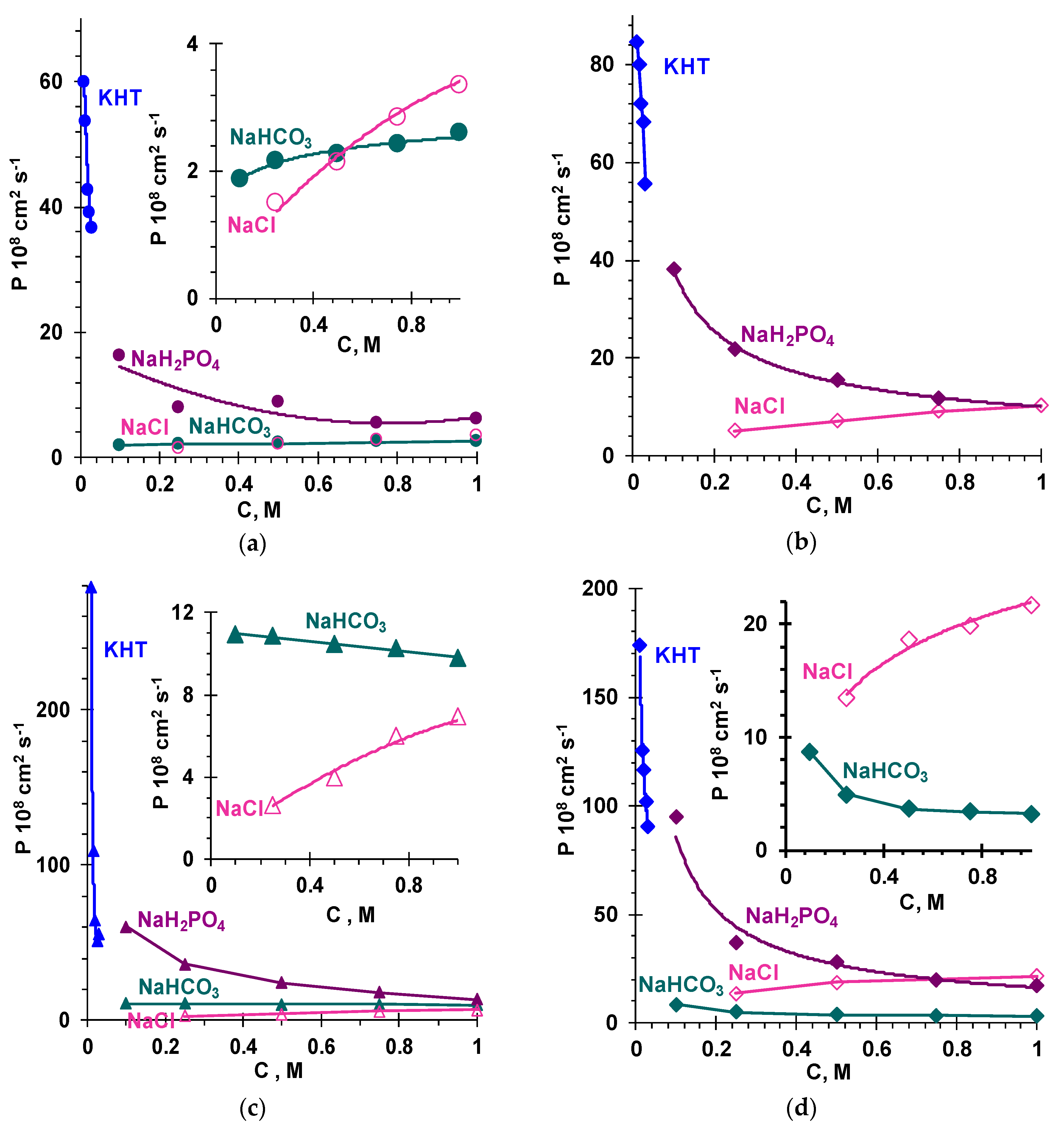
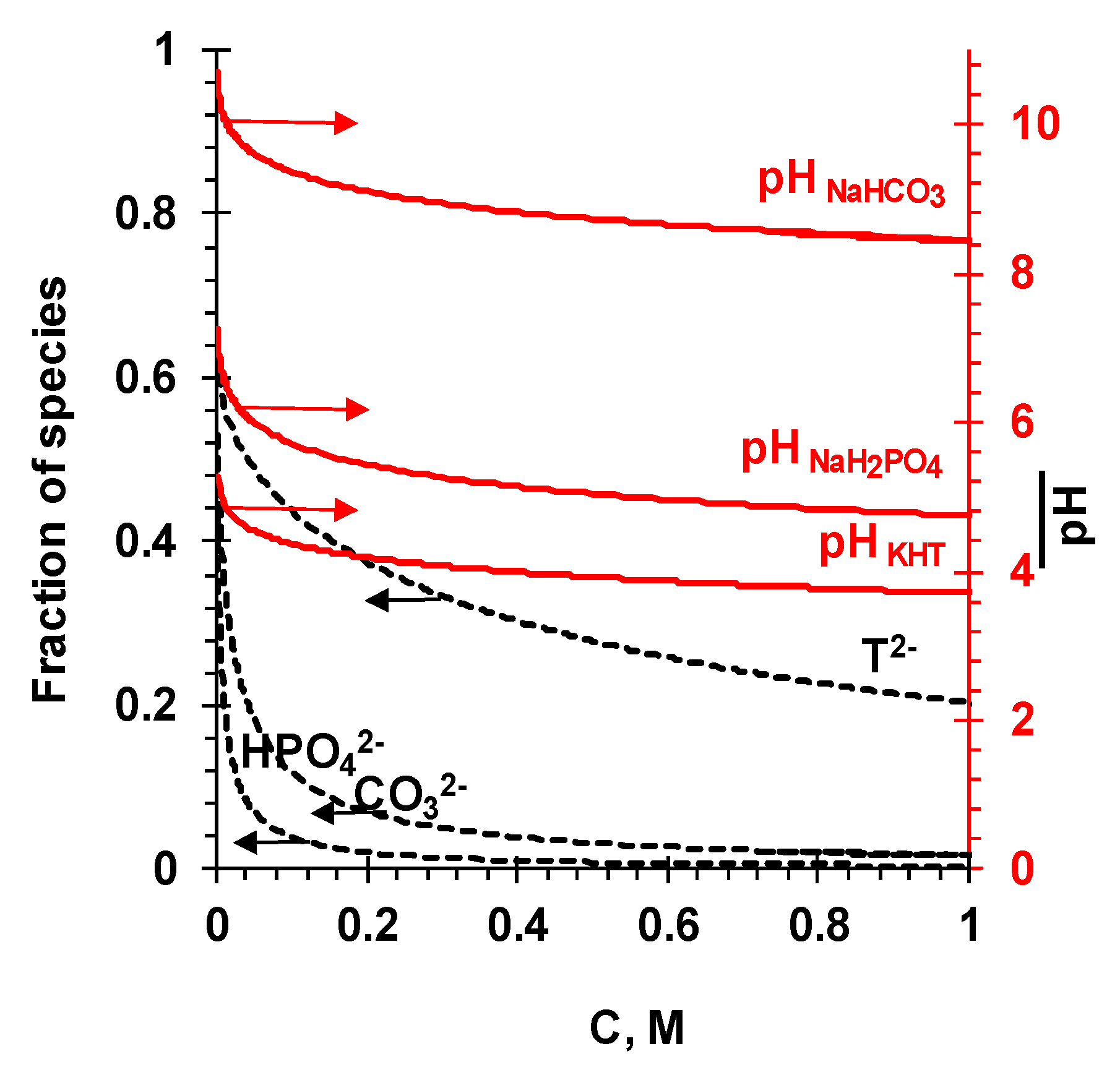
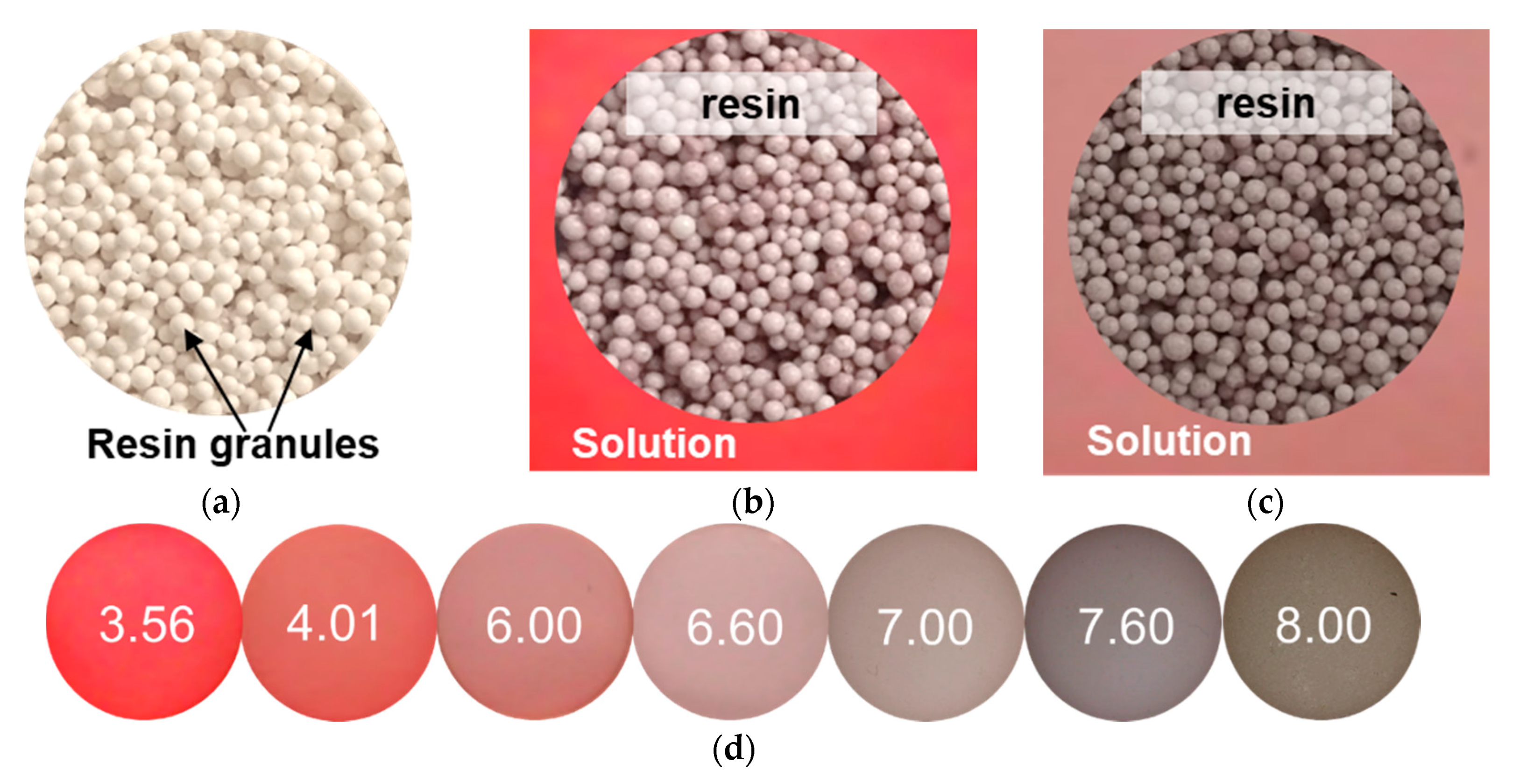
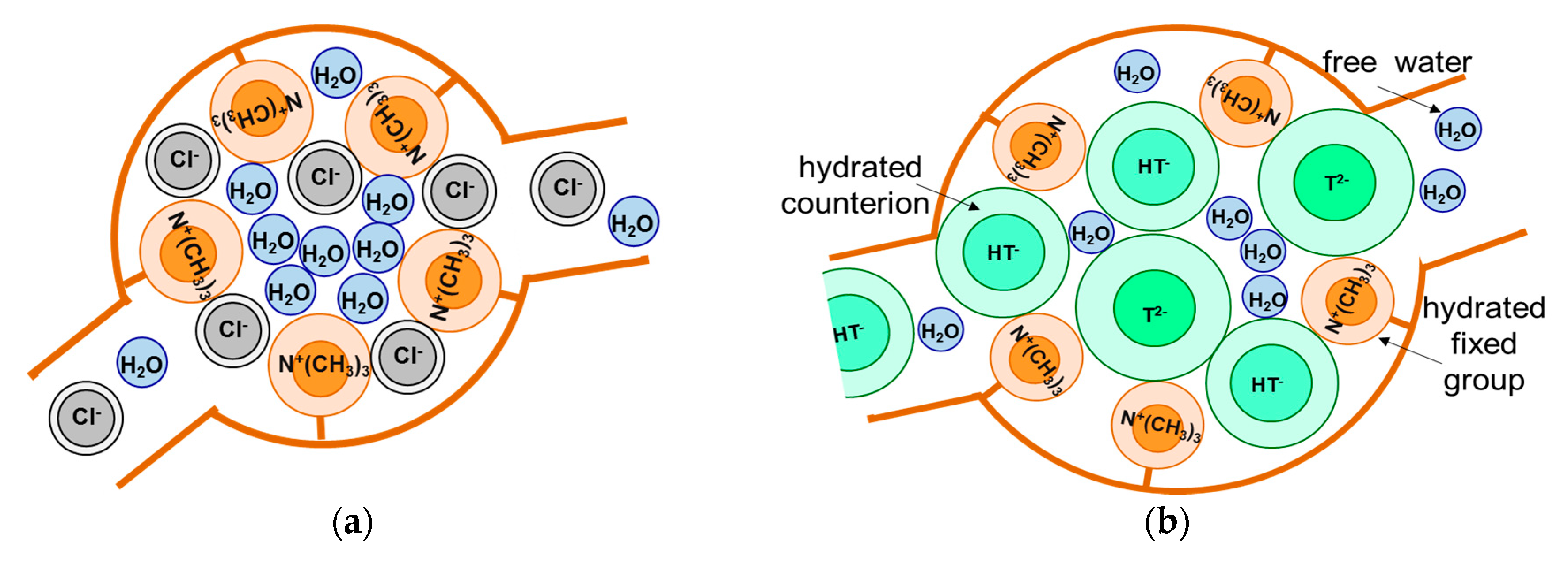
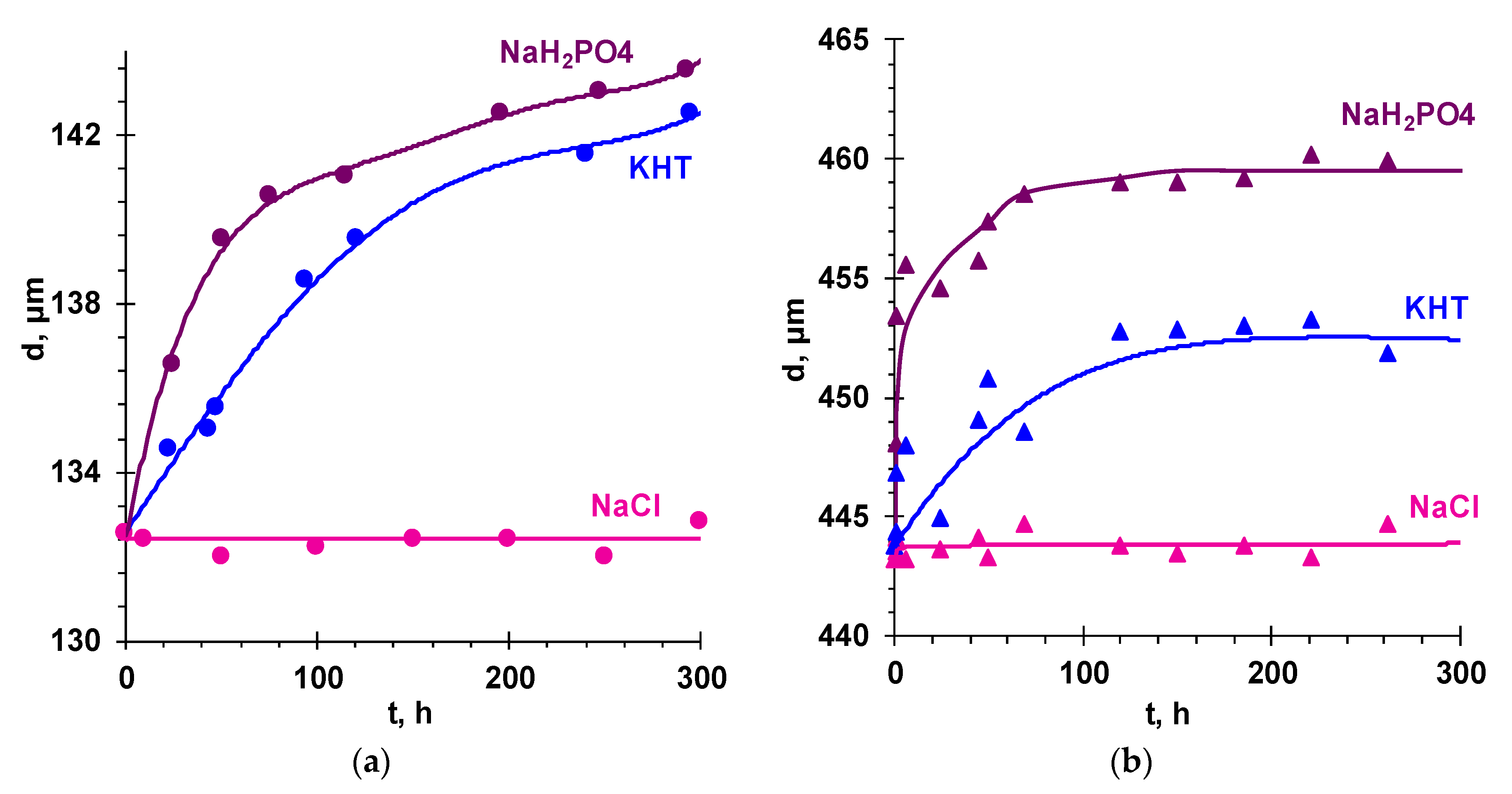
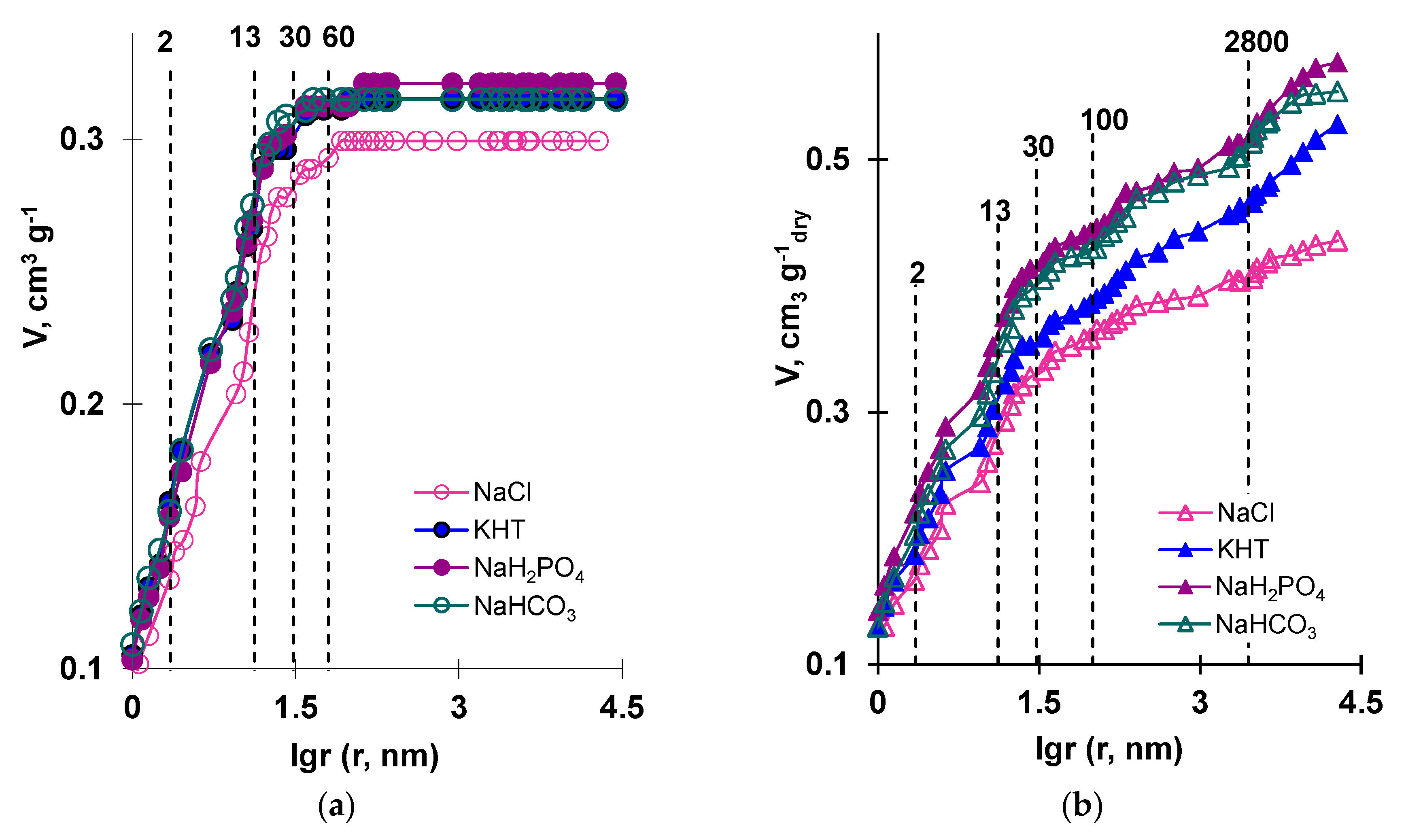
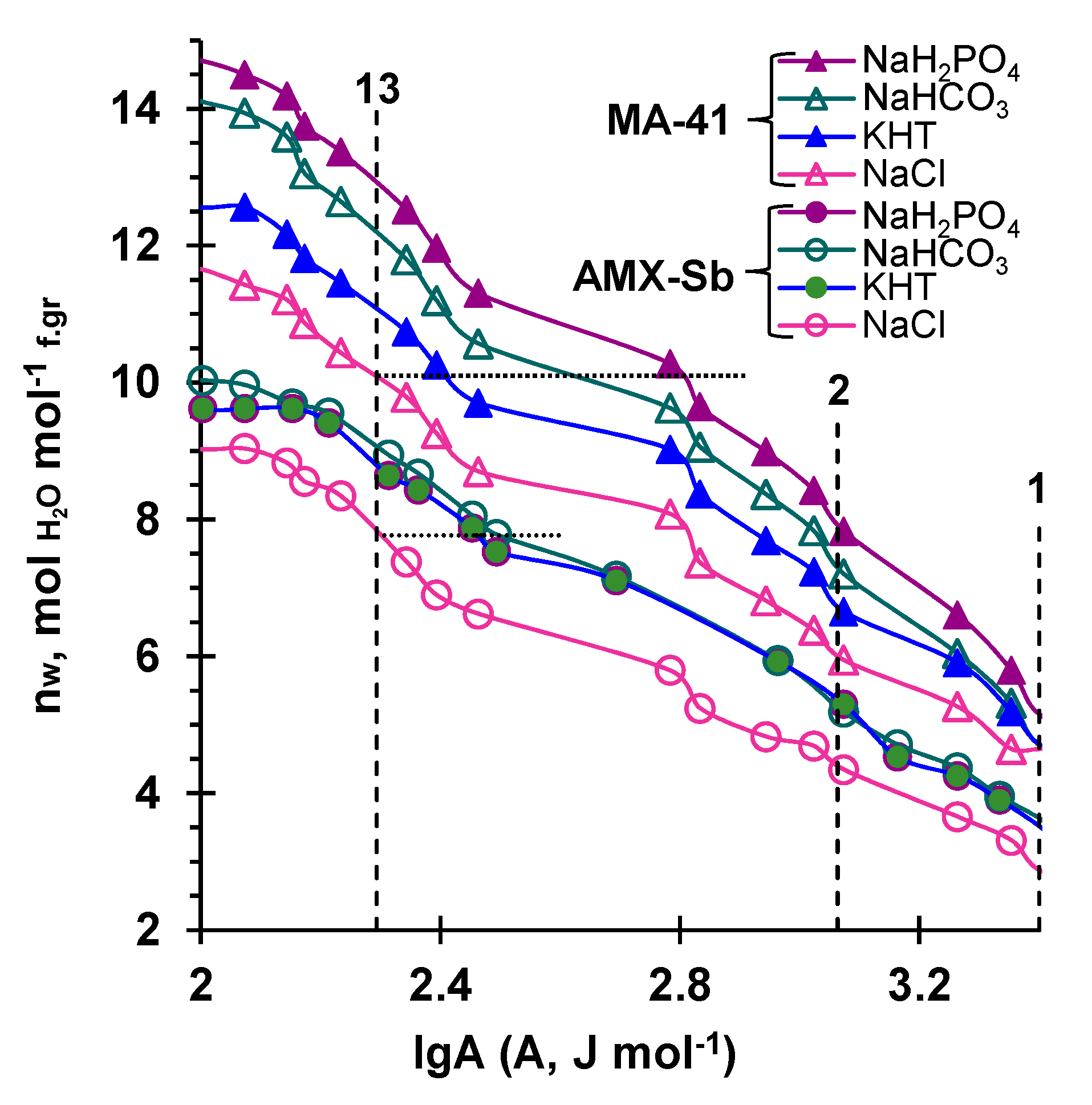

| Membrane | Thickness sw 1, μm | Water Content sw 1, % | Ion-Exchange Capacity, mmol g–1 dry | Ion-Exchange Capacity, mmol g–1 sw | Volume Fraction of Intergel Spaces, f2 |
|---|---|---|---|---|---|
| AMX-Sb | 130 ± 10 | 22 ± 2 | 1.71 ± 0.05 | 1.28 ± 0.05 | 0.11 ± 0.1 |
| AX | 160 ± 5 | 32 ± 2 | 2.68 ± 0.05 | 1.84 ± 0.05 | 0.12 ± 0.1 |
| MA-41 | 445 ± 5 | 28 ± 2 | 1.56 ± 0.05 | 1.08 ± 0.05 | 0.21 ± 0.1 |
| FTAM-EDI | 560 ± 5 | 34 ± 2 | 1.83 ± 0.05 | 1.21 ± 0.05 | 0.15 ± 0.1 |
| Electrolyte | pH |
|---|---|
| NaCl | 5.7 ± 0.1 |
| NaHCO3 | 8.3 ± 0.1 |
| NaH2PO4 | 4.6 ± 0.1 |
| KHT | 3.6 ± 0.1 |
| Counterion | Infinite Dilution Diffusion Coefficients, (T = 298 K), D 105, cm2 s−1 | Stokes Radius (T = 298 K), rSt, nm [23] | Gibbs Hydration Energy −Δhyd Go, kJ mol−1 | Hydration Number, h | |
|---|---|---|---|---|---|
| [39,40] | Other Sources | ||||
| Cl− | 2.032 [41] | 0.12 | 340 [39,40] | 2.0 | |
| HCO3− | 1.19 [41] | 0.21 | 335 [40] | 2.0 | 5.3 [42] |
| CO32− | 0.92 [41] | 0.27 | 1315 [39,40] | 4.0 | 8.5 [42] |
| H2PO4− | 0.958 [41] | 0.26 | 465 [40] | 1.5 | 7 [43] 9 ± 1 [44] |
| HPO42− | 0.759 [41] | 0.32 | 1089 [45] | 3 | 10 ± 3 [46] |
| PO43− | 0.7 [47] | - | 2765 [40] | 4.5 | 13 ± 3 [44] 15 ± 3 [46] |
| HT− | 0.852 [41] | 0.29 | - | - | - |
| T2− | 0.805 [23] | 0.30 | 1090 [48] | - | 14 ± 3 [49] |
| Range of the Pore Effective Radii, r | Water Content | NaCl | NaHCO3 | NaH2PO4 | KHT |
|---|---|---|---|---|---|
| Fraction in Total Water Content | |||||
| less than 1 nm | ΔV, cm3 g–1 | 0.089 | 0.099 | 0.095 | 0.094 |
| % | 30 | 31 | 30 | 30 | |
| 1–2 nm | ΔV, cm3 g–1 | 0.048 | 0.061 | 0.063 | 0.069 |
| % | 16 | 19 | 20 | 22 | |
| 2–13 nm | ΔV, cm3 g–1 | 0.105 | 0.116 | 0.112 | 0.108 |
| % | 35 | 37 | 35 | 34 | |
| 13–30 nm | ΔV, cm3 g–1 | 0.043 | 0.034 | 0.036 | 0.036 |
| % | 14 | 11 | 11 | 11 | |
| 30–60 nm | ΔV, cm3 g–1 | 0.010 | 0.005 | 0.008 | 0.008 |
| % | 3 | 2 | 2 | 2 | |
| 60–85 nm | ΔV, cm3 g–1 | 0.004 | 0.001 | 0.004 | 0.003 |
| % | 2 | >1 | 2 | 1 | |
| Vt, cm3 g–1 | 0.299 | 0.315 | 0.321 | 0.315 |
| Range of the Pore Effective Radii, r | Water Content | NaCl | NaHCO3 | NaH2PO4 | KHT |
|---|---|---|---|---|---|
| Fraction in Total Water Content | |||||
| less than 1 nm | ΔV, cm3 g–1 | 0.130 | 0.130 | 0.142 | 0.130 |
| % | 30 | 23 | 25 | 25 | |
| 1–2 nm | ΔV, cm3 g–1 | 0.038 | 0.060 | 0.087 | 0.060 |
| % | 9 | 11 | 15 | 11 | |
| 2–13 nm | ΔV, cm3 g–1 | 0.117 | 0.156 | 0.132 | 0.120 |
| % | 27 | 28 | 23 | 23 | |
| 13–30 nm | ΔV, cm3 g–1 | 0.047 | 0.057 | 0.054 | 0.047 |
| % | 11 | 10 | 9 | 9 | |
| 30–100 nm | ΔV, cm3 g–1 | 0.027 | 0.025 | 0.027 | 0.027 |
| % | 6 | 5 | 5 | 5 | |
| macropores 1 | ΔV, cm3 g–1 | 0.077 | 0.126 | 0.135 | 0.144 |
| % | 18 | 23 | 23 | 27 | |
| Vt, cm3 g–1 | 0.436 | 0.554 | 0.577 | 0.528 |
© 2019 by the authors. Licensee MDPI, Basel, Switzerland. This article is an open access article distributed under the terms and conditions of the Creative Commons Attribution (CC BY) license (http://creativecommons.org/licenses/by/4.0/).
Share and Cite
Pismenskaya, N.; Sarapulova, V.; Nevakshenova, E.; Kononenko, N.; Fomenko, M.; Nikonenko, V. Concentration Dependencies of Diffusion Permeability of Anion-Exchange Membranes in Sodium Hydrogen Carbonate, Monosodium Phosphate, and Potassium Hydrogen Tartrate Solutions. Membranes 2019, 9, 170. https://doi.org/10.3390/membranes9120170
Pismenskaya N, Sarapulova V, Nevakshenova E, Kononenko N, Fomenko M, Nikonenko V. Concentration Dependencies of Diffusion Permeability of Anion-Exchange Membranes in Sodium Hydrogen Carbonate, Monosodium Phosphate, and Potassium Hydrogen Tartrate Solutions. Membranes. 2019; 9(12):170. https://doi.org/10.3390/membranes9120170
Chicago/Turabian StylePismenskaya, Natalia, Veronika Sarapulova, Ekaterina Nevakshenova, Natalia Kononenko, Maria Fomenko, and Victor Nikonenko. 2019. "Concentration Dependencies of Diffusion Permeability of Anion-Exchange Membranes in Sodium Hydrogen Carbonate, Monosodium Phosphate, and Potassium Hydrogen Tartrate Solutions" Membranes 9, no. 12: 170. https://doi.org/10.3390/membranes9120170
APA StylePismenskaya, N., Sarapulova, V., Nevakshenova, E., Kononenko, N., Fomenko, M., & Nikonenko, V. (2019). Concentration Dependencies of Diffusion Permeability of Anion-Exchange Membranes in Sodium Hydrogen Carbonate, Monosodium Phosphate, and Potassium Hydrogen Tartrate Solutions. Membranes, 9(12), 170. https://doi.org/10.3390/membranes9120170








